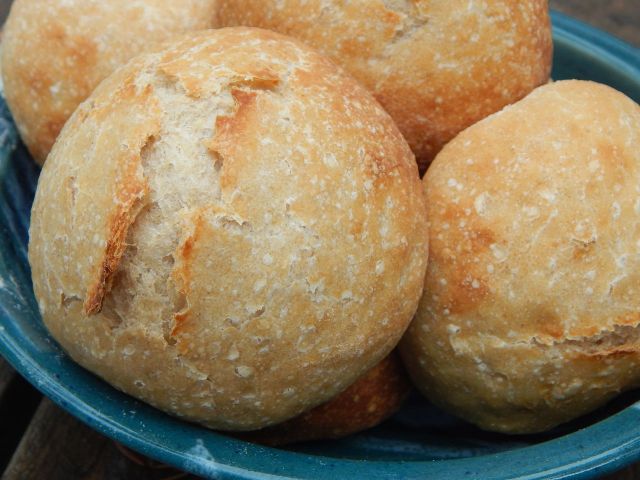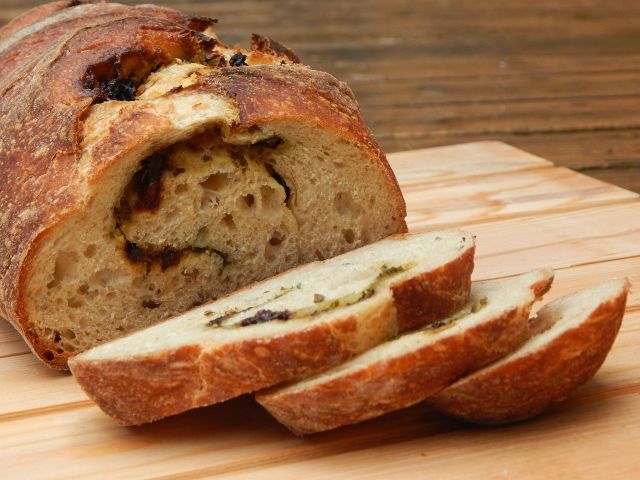
Long before I got hooked on sourdough, I made yeast-based Italian slipper bread using Patricia Wells’s Trattoria. I used the recipe from the 1993 edition of her book without changes because it is so good.
Once I started into sourdough, I fell for the flavor and texture of long-ferment loaves, and Sourdough Cabin Bread, aka Auntie Julie’s Special Bread, became my go-to recipe. But one day I flipped passed the slipper bread recipe and was inspired to create a version that could use sourdough starter.
Wells describes Italian slipper bread, or ciabatta, as “ideal for those who want great flavor in a hurry.” This sourdough version takes a little more time to build than a yeast loaf but far less than long-ferment doughs that spend hours to days in the fridge. It’s definitely a high-hydration dough: expect it to be wet, sticky, and hard to shape. Your final loaf will look different every time, with lots of holes inside, and will cool and be ready to eat more quickly than denser loaves.
Ready to give it a try? Full details are in the recipe below, but here are the basics:
You just need your Sourdough Starter, some all-purpose flour, and some kitchen staples.
1. Mix the ingredients.
2. Briefly stretch and fold the dough, and then go back to whatever else you were doing. Repeat, repeat, repeat—the quick folds are also your body’s stretch break for the next couple of hours.
3. Shape your loaf.
4. Bake, cool, and enjoy.
Still need sourdough starter? Get it from me for free through January 31, 2021!
 Make it, share it. Tag your photos: @twiceastastyblog and #twiceastastyblog
Make it, share it. Tag your photos: @twiceastastyblog and #twiceastastyblog
Sourdough Ciabatta
250 grams water
30 grams olive oil
350 grams all-purpose flour
10 grams (~1 tablespoon) salt
Set a large bowl on a kitchen scale and add the starter. Measure in the water and oil; stir briefly. Mix in the flour until combined. Cover with a damp tea towel; let rest for 30 minutes. Feed your starter.
Uncover the bowl, sprinkle in salt, and then fold the dough edges into the center several times until the salt is mixed in. Lift out the dough, oil the bowl lightly, return the dough to the bowl, and re-cover. Let rest for 30 minutes.
Over the first 2 hours, double-letter fold, like you would for Sourdough Cabin Bread, every 30 minutes: Transfer the dough to a floured work surface. Gently stretch it in four directions as far as it can go without tearing, forming a large rectangle. Fold 1/3 over and then the other 1/3 over, like folding a piece of paper for a letter. Rotate 90 degrees and repeat. Return the dough to the bowl, with the last folded edge on the bottom, and cover. Let stand for 30 minutes, and then repeat until you have folded and rested the dough 4 times. After the final fold, cover the bowl and let the dough rise for 1–2 hours, until nearly doubled in bulk.
Liberally flour your work surface and hands, and turn out the dough. Straighten the dough until it forms a rectangle roughly standard letter-paper size or your desired shape (see below).
In one quick move, lift the dough onto a piece of parchment paper. Let sit at room temperature while you preheat the oven and a baking stone, if using, to 425°F. When the oven’s ready, transfer the parchment and dough to the preheated baking stone or a baking sheet set on the oven’s upper-middle rack. Bake for 35 minutes, until hollow sounding when thumped. Transfer the loaf to a wire rack, and cool at least 1 hour before slicing. Makes 1 loaf.
Tips & Tricks
- Ciabatta dough is challenging to stretch and fold but for the opposite reason from Sourdough Rye Bread: Instead of being dense, ciabatta’s moisture content makes it ooze all over the place. But with each folding session, you’ll see and feel it hold together better.
- If you don’t have a baking stone, just use a cookie sheet—but don’t preheat it. You don’t need to cover this loaf: ciabatta is so moist that it will get plenty of oven spring.
- Be careful when moving the shaped dough and then the parchment paper; they can collapse easily. A pizza peel or extra baking sheet can help slide the parchment from one surface to another, as can quick, confident motions.
Twice as Tasty
 This may come as a surprise, but I truly am a lazy cook. I recommend a kitchen scale for sourdough because it’s more accurate than measuring by volume, but what I really love is that all I need to dirty are a bowl and a fork: no cemented sourdough on every measuring cup and spatula I own. Overall, I rely on an arsenal of basic recipes, like my improv, ratio, and master recipes, that I can adapt to my available ingredients and mood.
This may come as a surprise, but I truly am a lazy cook. I recommend a kitchen scale for sourdough because it’s more accurate than measuring by volume, but what I really love is that all I need to dirty are a bowl and a fork: no cemented sourdough on every measuring cup and spatula I own. Overall, I rely on an arsenal of basic recipes, like my improv, ratio, and master recipes, that I can adapt to my available ingredients and mood.
The same is true of sourdough: I use just a few recipes regularly to make many breads. I’ve shared some variations as their own recipes, but there are many other ways to alter your creations. With a handful of easily mastered recipes, you can make every batch of sourdough look and taste unique. Here are some of my favorite adjustments.
Change the Shape

You can bake Sourdough Ciabatta into many shapes. One large, irregular loaf is easiest, but you can use a dough scraper to split and shape the dough into two long loaves. Those loaves can even be divided into smaller, equally sized pieces and shaped into squarish rolls.
The same applies to many other dough recipes. I bake a two-loaf batch of Sourdough Cabin Bread as 3–4 smaller loaves for gifts. Dough for just one loaf can be shaped into 1 oblong with tapered ends, 6 slightly flattened Kaiser-style rolls, or 10–12 crusty dinner rolls. Rolls are especially nice if you forgot the dough in the fridge and it overproofed: Pry it from its container, divide it, shape each piece, and let it sit until you can preheat the oven.
I bake smaller loaves at the same temperature as the original recipe but knock off 5–10 minutes. I bake rolls made from any dough in the same way as Sourdough Brioche Buns.
Swap Ingredients
Doughs made with sourdough starter can be adapted to many flours, liquids, and other basic ingredients. For flour, I recommend starting small, swapping out 1/3 to 1/2 of the type called for in the recipe, to see how it affects the texture and rise, or making some hydration calculations. That’s how I moved from white flour to rye.
It pays to be cautious with liquids too, but you may end up replacing all the liquid with a variation. If you use milk, expect the final dough to have a softer crust and finer crumb. Whey can have a similar effect with more tang. Fermented pickle brine gives tang and flavor.
Other ingredient swaps include flavored salts, infused oils, and herb butters. Replace these at a 1:1 ratio and then add more flavor as desired.
- Sourdough Pizza Dough. Sprinkle the dough with 3–4 tablespoons of Italian Seasoning Blend or other dried herbs, or to taste, during the first kneading.
- Sourdough Ciabatta. Add 2 cubes of Basil Pesto Base when mixing the starter and water, leaving out the recipe’s oil and as much water as needed to keep the total liquid weight (280 grams) the same.
- Sourdough Cabin Bread. For a single loaf, chop 1/4 cup each Kalamata olives and Roasted Garlic and sprinkle it, along with 1/4 cup grated Parmesan and 2 teaspoons fresh rosemary, onto the stretched dough before the final fold. Alternatively, stretch the dough, spread on 2 tablespoons Basil Pesto Base, and then sprinkle on 2 tablespoons toasted pine nuts, 1/4 cup chopped sundried tomatoes, and 1/4 cup grated Parmesan; instead of folding, roll the dough into a long loaf, tucking in the ends.
Add Flavors

You can add an unexpected range of ingredients to your breads. Everything from citrus zests, to fresh or dried herbs, to spice blends, to cheese, to nuts and other chunky ingredients can be easily folded into the dough. I generally add powders and oil-based ingredients when I work in the salt and loose ingredients in the final double letter fold. Denser doughs are best for large ingredients, like roasted garlic, olives, sundried tomatoes, and crumbled cheese. Try adding flavors with these recipes:
Like what you’ve learned but don’t have a sourdough starter? Now’s your chance! The 4th Annual Sourdough Giveaway runs through January 31, 2021. Learn how to get your free sourdough starter here.

A very beautiful and versatile bread!
LikeLiked by 2 people